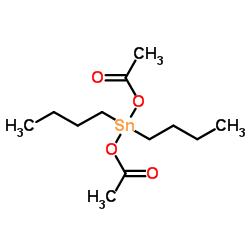Diacetoxy(dibutyl)stannane

Diacetoxy(dibutyl)stannane structure
|
Common Name | Diacetoxy(dibutyl)stannane | ||
|---|---|---|---|---|
| CAS Number | 1067-33-0 | Molecular Weight | 351.027 | |
| Density | 1.32 g/mL at 25 °C(lit.) | Boiling Point | 280.7±9.0 °C at 760 mmHg | |
| Molecular Formula | C12H24O4Sn | Melting Point | 7-10 °C(lit.) | |
| MSDS | Chinese USA | Flash Point | 123.6±18.7 °C | |
| Symbol |




GHS05, GHS07, GHS08, GHS09 |
Signal Word | Danger | |
|
Microcapsules for Enhanced Cargo Retention and Diversity.
Small 11 , 2903-9, (2015) Prevention of undesired leakage of encapsulated materials prior to triggered release presents a technological challenge for the practical application of microcapsule technologies in agriculture, drug delivery, and cosmetics. A microfluidic approach is reporte... |
|
|
Comparative teratogenicity of di-n-butyltin diacetate with n-butyltin trichloride in rats.
Arch. Environ. Contam. Toxicol. 23(2) , 216-22, (1992) Teratological tests were conducted on di-n-butyltin diacetate (DBTA), and n-butyltin trichloride (MBTC). Pregnant Wistar rats were treated orally with DBTA at doses of 0, 1.7, 5.0, 10.0, and 15.0 mg/kg/day or with MBTC at doses of 0, 50, 100, 200, and 400 mg/... |
|
|
Hamster cheek-pouch testing of dental soft polymers.
J. Dent. Res. 70(6) , 991-6, (1991) The hamster cheek pouch provides a suitable model system for the mucous-membrane irritation testing of dental materials. Poor retention of materials or difficulties in histopathological interpretation caused by surgical artifacts have been reported in publish... |
|
|
Critical gestational day of teratogenesis by di-n-butyltin diacetate in rats.
Bull. Environ. Contam. Toxicol. 49(5) , 715-22, (1992)
|
|
|
Effects of maternal age on teratogenicity of di-n-butyltin diacetate in rats.
Toxicology 167(3) , 181-9, (2001) The present study was designed to assess changes in the teratogenic potency of di-n-butyltin diacetate (DBTA) with increasing maternal age in rats. Pregnant Wistar rats of 3, 7.5 or 12 months were treated orally with DBTA at 0, 7.5, 10, 15 or 22 mg/kg on day ... |